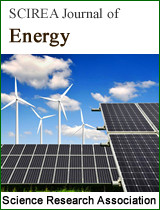Study of Enzymatic Saccharification and Fermentation of Hydrolyzed Mango Wood to Produce Biofuel for Electrochemical Renewable Energy in Fuel Cell
DOI: 396 Downloads 15383 Views
Author(s)
Abstract
Glucose based and alcohol based biofuels were produced from pretreated mango tree wood floor by enzymatic saccharification and fermentation. Two major components of plants, starch and cellulose, are both made up of sugars, the cellulose part of a plant is broken down to sugars and subsequently converted to ethanol. The acidic or alkaline pretreatment is found to be very effective to break complex organic polymer of cellulose and hemi-cellulose into simple monomer and removing lignin which is unleachable. The quantity of fuel produced was estimated as the amount oxygen required for its full combustion (COD mg/l). The total content of glucose based fuel formed by enzymatic saccharification is found to be less than the alcoholic based fuel formed by subsequent fermentation. The fuels are converted to pure electrical energy by electrochemical oxidation on a electrolytically developed MnO2. This inexpensive electrode outperformed the well known Pt electrocatalytic material and delivered a current density in the range of 5-12 mA/cm2
Keywords
Enzymatic Saccharification; Fermentation; Acid hydrolysis; woody biomass; Biofuel ; Fuel cell ; Electro catalytic material ;
Cite this paper
Subir Paul, Upendra Kumar,
Study of Enzymatic Saccharification and Fermentation of Hydrolyzed Mango Wood to Produce Biofuel for Electrochemical Renewable Energy in Fuel Cell
, SCIREA Journal of Energy.
Volume 1, Issue 1, October 2016 | PP. 39-59.
References
| [ 1 ] | Paul, S., and Jana, A., “Study on Bioelectrochemical Fuel Cell with Algae,” J. Inst. Eng. Interdisciplinary Div., 88,(2007) 27-30. |
| [ 2 ] | Paul, S., and Mondal, P., “Pyrolysis of Forest Residue for Production of Bio Fuel,” Int. Energy j., 7 (2006) , 221-225 |
| [ 3 ] | Paul, S., and Mondal, P., “Fabrication and Characterization of Bioelectrochemical Fuel Cell With Pyrolysed Produced Bio Oil and Hydrolysed Biomass By Fermentation,” J. Inst. Eng., Interdisciplinary 2009, 90, pp. 40-45. |
| [ 4 ] | Paul, S. “Characterization of Bioelectrochemical Fuel Cell Fabricated with Agriculture Wastes and Surface Modified Electrode Materials,” Journal of Fuel Cell Science and Technology ASME, 9 , (2012), pp. 021013 |
| [ 5 ] | Lee J., “Biological conversion of lignocelluloses biomass to ethanol,” Journal of Biotechnology, 56, (1997), pp.1– 24. |
| [ 6 ] | Iranmahbooba J; Nadima F; Monemib S., “Optimizing acid-hydrolysis: a critical step for production of ethanol from mixed wood chips, Biomass and. Bioenergy,” 22,(2002), pp. 401 – 404. |
| [ 7 ] | Daniel J. Schell; et. al., “A bioethanol process development unit: initial operating experiences and results with a corn,” ber feedstock, Bioresource Technology, 91, (2004), pp. 179–188. |
| [ 8 ] | Ehrman T. 1996, Determination of acid-soluble lignin in biomass.National Renewable Energy Laboratory, Technical ReportNREL-LAP-004, Golden, CO, USA, |
| [ 9 ] | Harris J.F., 1975 “Acid Hydrolysis and Dehydration Reactions for Utilling Plant Carbohydrates ,“Appl.Polym.Symp., pp.131-144. |
| [ 10 ] | Chang V S, Burr B, Holtzapple MT, 1997, Lime pretreatment of switchgrass., Applied Biochemistry and Biotechnology; 63, pp.:3–19. |
| [ 11 ] | Chang VS, Nagwani M, Kim C-H, Holtzapple M T. 1998, Lime pretreatment of crop residues: bagasse and wheat straw. Applied Biochemistry and Biotechnology;74,pp.135–59. |
| [ 12 ] | Karr W E, Holtzapple M T. 2000, Using lime pretreatment to facilitate the enzyme hydrolysis of corn stover. Biomass and Bioenergy;18, p.189–99. |
| [ 13 ] | Kim S, Holtzapple M T. 2005, Lime pretreatment and enzymatic hydrolysis of corn stover. Bioresource Technology; 96, pp.1994–2006. |
| [ 14 ] | Cheng S.A., Liu H., Logan B.E., 2006, “Increased Power Generation in a Continuous Flow MFC with Advective Flow through the Porous Anode and Reduced Electrode Spacing” Environ. Sci. Technol. 40, pp. 364–369. |
| [ 15 ] | Morris J.M., Jin S., Wang J.Q., Zhu C.Z., Urynowicz M.A., 2007, “Lead dioxide as an alternative catalyst to platinum in microbial fuel cells” Electrochem. Commun. 9, pp.1730–1734. |
| [ 16 ] | Li Y., Lu A.H., Ding H.R., Jin S., Yan Y.H., Wang C.Q., Zen C.P., Wang X., 2009, “Cr(VI) reduction at rutile-catalyzed cathode in microbial fuel cells” Electrochem. Commun. 11, pp. 1496–1499. |
| [ 17 ] | DAS D., SEN P. K. and DAS K., 2006, “Electrodeposited MnO2 as electrocatalyst for carbohydrate oxidation”, Journal of Applied Electrochemistry, 36, pp. 685–690. |
| [ 18 ] | Subir Paul and Asmita Ghosh, Electrochemical Characterization of MnO2 as Electrocatalytic Energy Material for Fuel Cell Electrode, Journal of Fuel Chemistry and Technology , Science Direct 2015,43(03), 344-351 |
| [ 19 ] | Subir Paul and Ruma Chatterjee, Development of Nano Carbon-MnO2 Energy Material for Glucose Fuel Cell Electrode, Namomaterials and Energy, ICE Pub.2015, Vol 3, p 1-9 http://dx.doi.org/10.1680/nme.14.00030 |
| [ 20 ] | Subir Paul and Asmita Ghosh, MnO2, a High Electrocatalytic Energy Material to Synthesis Energy from Oxidation of Methanol in Fuel Cell, ENERGY AND ENVIRONMENT FOCUS, 2015, vol 5, pp1-7 |
| [ 21 ] | Sujit Guchhait and Subir Paul, Synthesis and Characterization of ZnO-Al2O3 Oxides as Energetic Electrocatalytic Material for Glucose Fuel Cell, Journal of Fuel Chemistry and Technology, 2015, Vol. 43 Issue (08): 1004-1010 |
| [ 22 ] | Mohamedi M, Hisamitsu Y, Kihara K, Kudo T, Itoh T, Isamu Uchida, 2001, “Ni–Al alloy as alternative cathode for molten carbonate fuel cells ,”Original Research Article Journal of Alloys and Compounds, 315,pp. 224-233. |
| [ 23 ] | Suresh Kumar K., Haridoss Prathap, Seshadri S.K., 2008, “ Synthesis and characterization of electrodeposited Ni–Pd alloy electrodes for methanol oxidation,” Original Research Article. Surface and Coatings Technology, 202 : 1764-1770. |

